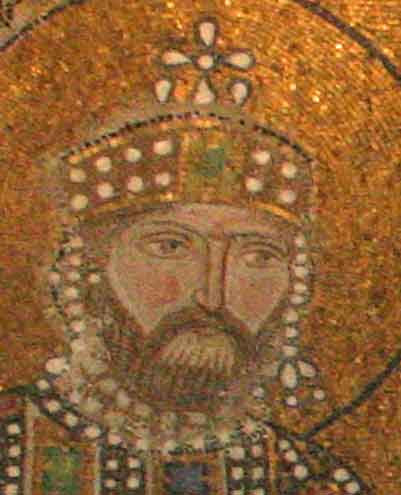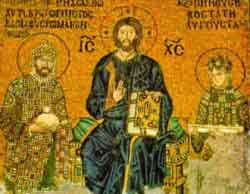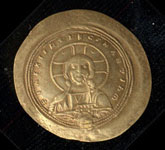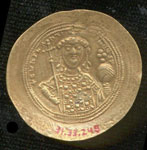.

Constantine IX Monomachos (Greek: Κωνσταντίνος Θ΄ Μονομάχος, Kōnstantinos IX Monomakhos), c. 1000 - January 11, 1055, reigned as Byzantine emperor from June 11, 1042 to January 11, 1055. He had been chosen by Zoe as a husband and co-emperor in 1042, although he had been exiled for conspiring against her previous husband, Emperor Michael IV. They ruled together until Zoe died in 1050.

Mosaic of Constantine IX and Empress Zoe
Life
Constantine Monomachos was the son of Theodosios Monomachos, an important bureaucrat under Basil II and Constantine VIII. At some point Theodosios had been suspected of conspiracy and his son's career suffered accordingly. Constantine's position improved after he married, as his second wife, a niece of Emperor Romanos III Argyros. Catching the eye of the Empress Zoe, Constantine was exiled to the island of Lesbos by her second husband, Michael IV. He was retrieved from exile in 1042, when he was appointed judge in Greece, but before he undertook his appointment, Constantine was summoned to Constantinople as Zoe's choice for husband. The pair were married on June 11, 1042, without the participation of Patriarch Alexius I of Constantinople, who refused to officiate over a third marriage (for both spouses). On the following day Constantine was formally proclaimed emperor together with Zoe and her sister Theodora.


Histamenon of Constantine IX Monomachos
Constantine IX Monomachos purged the relatives of Michael IV from the court. The new emperor was pleasure-loving and prone to violent outbursts on suspicion of conspiracy. He was heavily influenced by his mistress, Maria Skleraina, a niece of his second wife, and Maria's relatives. In August 1042, under the influence of the Skleroi, the emperor relieved General George Maniakes from his command in Italy, and Maniakes rebelled, declaring himself emperor in September. He transferred his troops into the Balkans and was about to defeat Constantine's army in battle, when he was wounded and died on the field, ending the crisis in 1043.
Immediately after the victory, Constantine was attacked by a fleet from Kievan Rus', which had probably been hired by Maniakes. They too were defeated, with the help of Greek fire. Constantine married his daughter Anastasia (daughter from his second marriage), to the future Prince Vsevolod I of Kiev, the favorite son of his dangerous opponent Yaroslav I the Wise by Ingegerd Olofsdotter.
In 1045 Constantine annexed the Armenian kingdom of Ani, but this expansion merely exposed the empire to new enemies. In 1046 the Byzantines came into contact for the first time with the Seljuk Turks. They met in battle in Armenia in 1048, and settled a truce the following year. However, Constantine foolishly disbanded the Armenian troops to save money in 1053, leaving the eastern frontier poorly defended at precisely the moment when its defences should have been strengthened. Even if Seljuk rulers were willing to abide by the treaty, their unruly Turcoman allies showed much less restraint. , Thus Constantine IX weakened the Byzantine forces, which in turn led to their cataclysmic defeat at the battle of Manzikert in 1071.
In 1047 Constantine IX was faced by the rebellion of his nephew Leo Tornikios in Adrianople. Tornikios gained support in most of Thrace and vainly attempted to take Constantinople. Forced to retreat, Tornikios failed in another siege, and was captured during his flight. The revolt had weakened Byzantine defenses in the Balkans and in 1048 the area was raided by the Pechenegs, who continued to plunder it for the next 5 years. The emperor's efforts to contain the enemy through diplomacy merely exacerbated the situation, as rival Pecheneg leaders clashed on Byzantine ground, and Pecheneg settlers were allowed to live in compact settlement in the Balkans, making it difficult to suppress their rebellion. Faced with such difficulties, Constantine IX may have sought Hungarian support.
Internally, Constantine IX sought to secure his position by favoring the nobility (dynatoi) and granted generous tax immunities to major landowners and the church. Similarly, he seems to have taken recourse to the pronoia system, a sort of Byzantine feudal contract in which tracts of land (or the tax revenue from it) were granted to particular individuals in exchange for contributing and maintaining military forces. Both expedients gradually compromised the effectiveness of the state and contributed to the development of the crisis that engulfed Byzantium in the second half of the 11th century.
In 1054 the centuries-old differences between the Greek and Roman churches led to their final separation. Legates from Pope Leo IX excommunicated the Patriarch of Constantinople Michael Keroularios when Keroularios would not agree to adopt western church practises, and in return Keroularios excommunicated the legates. This sabotaged Constantine's attempts to ally with the Pope against the Normans, who had taken advantage of Maniakes' disappearance to take over Southern Italy.
Constantine tried to intervene, but he fell ill and died on January 11 of the following year. Theodora, the elderly daughter of Constantine VIII who had ruled with her sister Zoe since 1042, was recalled from her retirement and named empress.
Constantine IX was also a patron of the arts and literature, and during his reign the university in Constantinople expanded its juridical and philosophical programs. The literary circle at court included the philosopher and historian Michael Psellos, whose Chronographia records the history of Constantine's reign. Psellos left a physical description of Constantine in his Chronographia: he was "ruddy as the sun, but all his breast, and down to his feet... [were] colored the purest white all over, with exquisite accuracy. When he was in his prime, before his limbs lost their virility, anyone who cared to look at him closely would surely have likened his head to the sun in its glory, so radiant was it, and his hair to the rays of the sun, while in the rest of his body he would have seen the purest and most translucent crystal."
Overall, his reign was a disaster for the Byzantine empire; in particular, the miltary weakness for which he was largely responsible greatly contributed to the subsequent loss of Asia Minor to the Turks, and the ultimate fall of Constantinople to the Muslim Ottomans in 1453.
Constantine's family name Monomachos ("one who fights alone") was inherited by his Kievan grandson, Vladimir II Monomakh.
Family
By his first wife (who is anonymous), Constantine Monomachos is not known to have had children. His second wife, a member of the Skleros clan, and the niece of Emperor Romanos III, was probably the mother of:
- Anastasia, who married Vsevolod I of Kiev.
Constantine IX had no children by his third wife, the aging Zoe, or by his mistress Maria Skleraine, the niece of his second wife.
References
The Oxford Dictionary of Byzantium, Oxford University Press, 1991
Byzantine Emperor
Preceded by: Zoe
Succeeded by: Theodora
| Ancient Greece
Science, Technology , Medicine , Warfare, , Biographies , Life , Cities/Places/Maps , Arts , Literature , Philosophy ,Olympics, Mythology , History , Images Medieval Greece / Byzantine Empire Science, Technology, Arts, , Warfare , Literature, Biographies, Icons, History Modern Greece Cities, Islands, Regions, Fauna/Flora ,Biographies , History , Warfare, Science/Technology, Literature, Music , Arts , Film/Actors , Sport , Fashion --- |
Retrieved from "http://en.wikipedia.org"
All text is available under the terms of the GNU Free Documentation License

